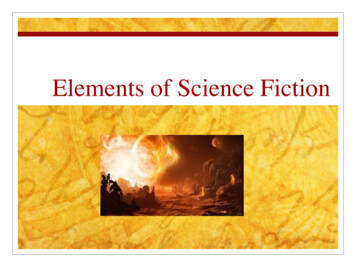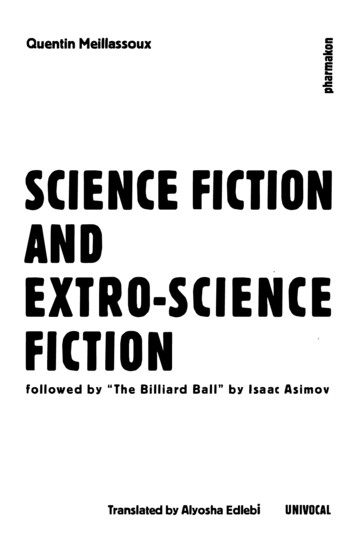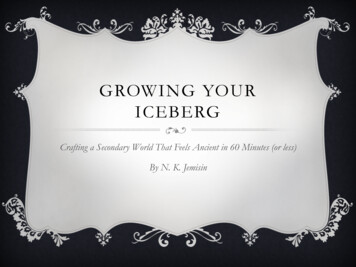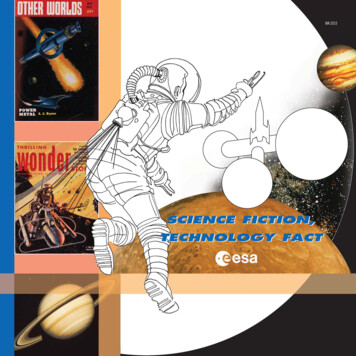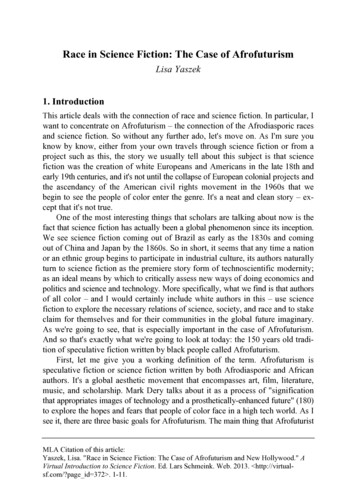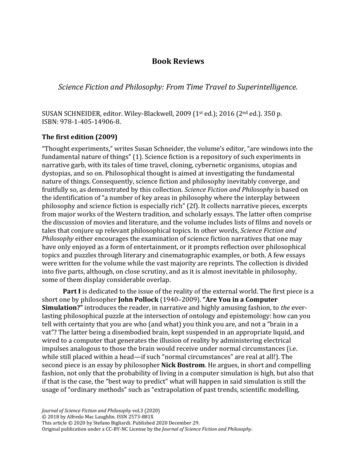
Transcription
Book ReviewsScience Fiction and Philosophy: From Time Travel to Superintelligence.SUSAN SCHNEIDER, editor. Wiley-Blackwell, 2009 (1st ed.); 2016 (2nd ed.). 350 p.ISBN: 978-1-405-14906-8.The first edition (2009)“Thought experiments,” writes Susan Schneider, the volume’s editor, “are windows into thefundamental nature of things” (1). Science fiction is a repository of such experiments innarrative garb, with its tales of time travel, cloning, cybernetic organisms, utopias anddystopias, and so on. Philosophical thought is aimed at investigating the fundamentalnature of things. Consequently, science fiction and philosophy inevitably converge, andfruitfully so, as demonstrated by this collection. Science Fiction and Philosophy is based onthe identification of “a number of key areas in philosophy where the interplay betweenphilosophy and science fiction is especially rich” (2f). It collects narrative pieces, excerptsfrom major works of the Western tradition, and scholarly essays. The latter often comprisethe discussion of movies and literature, and the volume includes lists of films and novels ortales that conjure up relevant philosophical topics. In other words, Science Fiction andPhilosophy either encourages the examination of science fiction narratives that one mayhave only enjoyed as a form of entertainment, or it prompts reflection over philosophicaltopics and puzzles through literary and cinematographic examples, or both. A few essayswere written for the volume while the vast majority are reprints. The collection is dividedinto five parts, although, on close scrutiny, and as it is almost inevitable in philosophy,some of them display considerable overlap.Part I is dedicated to the issue of the reality of the external world. The first piece is ashort one by philosopher John Pollock (1940–2009). “Are You in a ComputerSimulation?” introduces the reader, in narrative and highly amusing fashion, to the everlasting philosophical puzzle at the intersection of ontology and epistemology: how can youtell with certainty that you are who (and what) you think you are, and not a “brain in avat”? The latter being a disembodied brain, kept suspended in an appropriate liquid, andwired to a computer that generates the illusion of reality by administering electricalimpulses analogous to those the brain would receive under normal circumstances (i.e.while still placed within a head—if such “normal circumstances” are real at all!). Thesecond piece is an essay by philosopher Nick Bostrom. He argues, in short and compellingfashion, not only that the probability of living in a computer simulation is high, but also thatif that is the case, the “best way to predict” what will happen in said simulation is still theusage of “ordinary methods” such as “extrapolation of past trends, scientific modelling,Journal of Science Fiction and Philosophy vol.3 (2020) 2018 by Alfredo Mac Laughlin. ISSN 2573-881XThis article 2020 by Stefano Bigliardi. Published 2020 December 29.Original publication under a CC-BY-NC License by the Journal of Science Fiction and Philosophy.
Book Review: Science Fiction and Philosophycommon sense, and so on” (22). Bostrom’s essay is followed by the very well-known pagesfrom Plato’s (ca. 428–348 BCE) Republic in which Socrates narrates the Allegory of theCave, and by a likewise known excerpt from René Descartes’s (1596–1650) TheMeditations on First Philosophy (1641) in which the French philosopher discusses howreality and dream (or deception) are ultimately indistinguishable. The section ends with“The Matrix as Metaphysics,” an essay by David J. Chalmers that merges the classical“brain in a vat” with the movie The Matrix (1999). Chalmers contends that even if theMatrix Hypothesis were true, i.e., if it were true that one is, and has always been, in “anartificially designed computer simulation of the world” (34), this would not result in thefalsification of most of their beliefs. Chalmers namely considers it a metaphysicalhypothesis, i.e., “a hypothesis about the underlying nature of reality” including the reality ofphysics, human mind, and the world (36) and demonstrates that the application of such ahypothesis to each one of said fields is coherent (that is, the hypothesis cannot be ruledout). Chalmers concludes, however, that we should not reject our “ordinary beliefs aboutthe external world,” even if we had evidence that we do live in such a scenario. At most, weshould “revise [our] beliefs about the underlying nature of [our] world” (42). Chalmers alsosystematically addresses and neutralizes multiple objections to his argument. While I keepthe overall critical evaluation of the volume for the end, I feel compelled to anticipate thatthis is an excellent, crystal clear essay, in which, despite the objective difficulty of thematter discussed, Chalmers admirably keeps jargon down to a minimum.Part II discusses free will and the nature of persons. The first piece is a hilarious,thought-provoking tale by Daniel C. Dennett. He narrates “Where Am I?” in the firstperson, undergoing a brain-transplant (or perhaps a body-transplant) experiment.Dennett’s tale, dense and entertaining, can hardly be summarized, and in any case I am notwilling to spoil the readers’ amusement and surprise. Suffice it to say that, through thewitty account of how, in the interests of a Pentagon mission, his brain was placed into a lifesupporting mechanism in order for it to command the body from afar through transceiversattached to nerve stumps in the cranium, Dennett brilliantly manages to conveyfundamental questions and original ideas, if perhaps counterintuitive ones, about thenature of the self. The second piece is “Personal Identity,” a lengthier and moreconventional essay by Eric Olson, surveying the main issues related to the titular concept.As Olson makes clear, the cluster of questions revolving around the issue of personalidentity, while being rooted in traditional debates such as what happens after we die (andwhat possibly constitutes survival after physical death), also bear major ethicalimplications for contemporary ethical discussions, for instance in regard to the status ofembryos or of comatose persons. Olson places a special focus on the question of persistence,or “what is necessary and sufficient for a past or future being to be you” (71), that he iscareful to distinguish from other ones it is often mixed up with. For Olson, the correct wayof formulating it is this: “under what possible circumstances is a person who exists at onetime identical with something that exists at another time (whether or not it is a personthen)?” (74, emphasis in the original). In other words, Olson discards the idea that being aperson is an essential feature of the identity that can be conserved over time. On suchpremises, he examines the idea that persistence is the continuity of mental featuresJournal of Science Fiction and PhilosophyVol. 3: 20202
Book Review: Science Fiction and Philosophy(Psychological Approach), or that it consists of being the same biological organism(Somatic Approach), but he also carefully considers “anticriterialism,” i.e. the viewaccording to which neither psychological nor somatic continuity may be necessary andsufficient for persistence, but “a person existing at one time is identical with a beingexisting at another time if and only they are identical” (76). Olson gives a detailed accountof the challenges faced by each option, and concludes that the issue of persistence not onlymay not have a “unique right answer” (86) but also that personal identity can only bedefined in the framework of “more general metaphysical considerations” (87), that is, ofunderlying issues that need to be addressed even before analyzing identity itself. The thirdpiece, “Divided Minds and the Nature of Persons” by Derek Parfit (1942–2017),discusses the problems raised by the phenomena observed upon disconnecting a person’sbrain hemispheres. Parfit initially seems to support the opinion that, even if one of thehemispheres is sub-dominant, that is, less developed than the other, then there are twodistinct streams of consciousness. He eventually argues, however, that the number ofpersons involved in such an event is not two, but ultimately none. In Parfit’s opinion wenamely are not what we believe we are: accurate scrutiny of the split-brain case, in hisinterpretation, supports the “Bundle Theory” i.e., that “there are long series of mentalstates and events [.] each series [being] unified by various kinds of causal relation” (92). Inother words, analytical observation of the consequences of the hemispheres’ disconnection,in Parfit’s opinion, reveals the weakness of any explanation of consciousness in terms of aperson or an ego. Imagine that a man with a split brain is holding a placard with a red halfand a blue half. In one stream he is seeing red (combined with other sensations, forinstance of the room around the subject), and in the other one he is seeing blue (again,combined with other sensations). If we claim that each such stream, consisting of a colorplus the other sensations, is internally “unified” by being had by the same person, weignore the fact the two streams are not being united; one may thus be tempted to resort toa concept of “subject of an experience” as distinct from that of person (each stream beingunified by one such subject), but such a notion would be automatically suspicious, pointsout the author. Parfit suggests, then, that concepts like “person” or “ego” or “subject ofexperience” are “idle cogs” (97) and that the case of the split brain only sheds light on theordinary fact that there are no such unifying elements even in ordinary awareness, the unityof consciousness being rather explained by the fact that “ordinary people are, at any time,aware of having several different experiences” (Ibidem). While touching upon the historicalorigins of the Bundle Theory, Parfit is also careful to point out the analogies between theversions in which it emerged among Western thinkers, and some teachings of the Buddha.The fourth piece is a short one by inventor and futurist Ray Kurzweil, “Who Am I? WhatAm I?” He starts with the observation according to which the molecules that make up ourbody and brain change, and rapidly at that. What persists is rather the pattern, but evensuch a pattern changes, although “slowly and in a continuum” (100). Kurzweil quickly buteffectively explores the consequences (and the related dilemmas) of the fact that such apattern could be replicated, and hence shared by another being—would that being be us?The replica may be indistinguishable by others, points out Kurzweil, but it would not be us.What about slowly replacing a brain with its “neuromorphic equivalents,” then? In such aJournal of Science Fiction and PhilosophyVol. 3: 20203
Book Review: Science Fiction and Philosophycase, he points out, it would be difficult to draw the line where the “old me” was replacedby the “new” one; however, such replacement is ultimately what happens in our bodiesnormally. Kurzweil concludes his pages emphasizing that, while he remains a “patternist”as far as the issue of personal identity is concerned, he as well acknowledges that there is asubjective, ontological reality of consciousness that we have no direct access to—exceptwithin ourselves; “we can’t propose an objective consciousness detector,” he states,“without philosophical assumptions built into it” (102). The fifth piece, “Free Will andDeterminism in the World of Minority Report,” by Michael Huemer, is, as its very titlemakes clear, a discussion of free will in the context of Steven Spielberg’s 2002 movieloosely based on Philip K. Dick’s 1956 short story “The Minority Report.” In the movie’sdystopian reality, the police stop criminals before they take action thanks to the “precogs,”three individuals endowed with foresight of criminal actions, although from time to timeone of them has a different prediction, that is, a minority report. If our fate ispredetermined, and if there is no such thing as free will, is it just to punish someone forsomething that they have not committed, and that in any case they would have committedout of necessitation? Huemer explores in this regard the options of “soft determinism,” thatis, a simultaneous espousal of the idea that humans do have freedom of will while theiractions also are determined. For instance, one can think that a person’s actions aredetermined by past causes, but still argue that such person does have alternativepossibilities which, if the person tried to do, they would succeed, in harmony with the lawsof the world—although ultimately that person’s choice is determined. Another option is toclaim that freedom is defined in regard to internal causes, such as beliefs and desires, not toexternal forces, determinism holding valid only for the latter. A third option is to claim thatfreedom requires determinism; otherwise, our actions would be completely randomoccurrences. Huemer objects, however, that criticism of soft determinism seems strongerthan such options: if, as it seems to be the case, neither the laws of nature nor the eventsprior to our birth are up to us, then all the consequences of such events including ourcurrent acts are not up to us. Eventually, Huemer scrutinizes the arguments in support ofthe idea that free will does exist and that determinism is false, also known asLibertarianism (not to be confused with the political theory of the same name). Oneargument is that we introspectively feel our freedom while making choices. Anotherargument is that if determinism is true, each thinker is also determined to believe (ordisbelieve) in it and therefore there is no way to know whether determinism is true.“Minority reports” would be interpreted by the advocates of free will as proof of itsexistence, while determinists would see them as nothing but a sign of the pre-cogs’fallibility. Huemer concludes that the characters of Minority Report, while choosing toabolish their “Precrime system” may have had a wrong motivation since they decided to doso considering that the system was fallible; nevertheless, they did the right thing, accordingto Huemer, since he is inclined to espouse Libertarianism and, before an individual makesan actual choice to commit a crime, “there is no existing fact or state of affairs that makeshim a ‘future criminal’ or deserving of punishment” (111). Part II beautifully ends with aone-page text by Alvin I. Goldman, “The Book of Life: A Thought Experiment.” A briefand brilliant narrative, it is one of the most entertaining of the whole collection, aimed atJournal of Science Fiction and PhilosophyVol. 3: 20204
Book Review: Science Fiction and Philosophysparking further thoughts about determinism and free will. The short tale is written in thefirst person and talks about someone who finds a tome describing their life in detail upuntil and including the very moment in which the book is being perused.Part III deals with the concept of human mind: its definition, its distinction fromartificial minds, and the scenarios opened up by the hybridization of human and artificialmind or the latter’s enhancement. The first piece is a short story by Isaac Asimov (1920–1992), “Robot Dreams” (1986), narrating how researchers identify in a robot’s declaredcapacity of dreaming the dangerous potential for rebellious action. The second piece, “ABrain Speaks,” by Andy Clark, is another narrative in the first person singular (“I amJohn’s brain”, 122) that, not dissimilarly from previous ones, raises profound questionsunder a veneer of levity, making the reader realize how little we know about our brain: “weremain strangers despite our intimacy (or perhaps because of it)” (125) and we tend toforget that such organ is “in large part a survival-oriented device that greatly predates theemergence of linguistic abilities” but also that its “role in promoting conscious andlinguaform cognition is just a recent sideline” (Ibidem).I am tempted to call the third piece, Ned Block’s “The Mind as the Software of theBrain,” a mini-book within the book. This chapter spans 47 pages (including two ofbibliographic references). “Cognitive scientists often say that the mind is the software ofthe brain,” starts off Block, “this chapter is about what this claim means” (26). So begins averitable tour de force, occasionally enriched with diagrams, in which the reader is takenthrough a meticulous and not infrequently technical examination of differentconceptualizations of intelligence. The author begins by discussing Alan M. Turing’s (1912–1954) famous test. Turing attempted a definition of intelligence that was behavioristic, thatis, formulated without resorting to mental states (that are not intersubjectively accessible)but rather in reference to dispositions, “the tendency to emit certain behaviors givencertain stimuli” (126). A machine is intelligent, according to Turing, if it passes the test of,to put it bluntly, fooling a human judge to think that it is a person. Block points out,however, that if a machine is designed to perform a certain job, it is better to test it on theperformance: “who cares if it doesn’t pass the Turing test?” (127). Furthermore, points outBlock, experience teaches that simple programs like Joseph Weizenbaum’s (1923–2008)ELIZA can pass the test, which compromises its validity as even just a sufficient conditionfor intelligence. Another challenge is that it remains unspecified how the judges should bechosen and, if one stipulates that a judge must be knowledgeable about computers orthought, this move re-introduces a mentalistic criterion. Block delivers another blow toTuring’s argument by hypothesizing a “machine that contains all conversations of a givenlength in which the machine’s replies make sense” (131, emphasis in the original). Blocksdemonstrates that, although such a machine processes information in an unintelligent way,it still passes the Turing test. The problem with such a test, points out Block, is that “itfocuses on performance rather than competence. [The former] is evidence for competence,but the core of our understanding of the mind lies with mental competence, not behavioralperformance” (132). Block also observes that Turing produced a definition of intelligence,rather than its exploration, similar to one who describes how the word “water” is usedJournal of Science Fiction and PhilosophyVol. 3: 20205
Book Review: Science Fiction and Philosophyrather than investigating its physico-chemical constitution. However, Block points outdrawing on such a comparison, “water” is a structural kind, i.e., it has a “hiddencompositional essence” (133), that is, its molecular arrangement. But there also arefunctional kinds, like “mousetrap” or “gene,” that are defined by their causal role.Intelligence belongs to this latter kind, but it still makes sense to investigate itexperimentally. Functional analysis attempts to identify “primitive processes.” It tries tobreak down intelligent capacities to totally mechanical, and hence fundamentally bottomlevel, processes. Block, however, explains in detail that cognitive science is concerned withwhat a processor does (its function) and not with how it does it. Since the same functioncan be fulfilled by different (primitive) processors (say, hydraulically or electrically), thecomputer model of the mind may apply to biological brains as well as to non-biologicalsystems. Block dedicates a section of his essay to the discussion of how intentionality (or“aboutness”) and intelligence are related. The former is the capacity to represent a state ofthe world; the latter is the capacity to do something. Intentionality is past-oriented, andintelligence is future-oriented. Their relationship, points out Block, is controversial, sincesome authors contend that you can have one without the other; for instance, tree rings canrepresent a tree’s age, but they cannot be said to be “intelligent.” The analysis ofcomputational systems that process abstractions (numbers, or things in the world),explains Block, reaches a basic level in which one can only describe a primitive processoras manipulating symbols according to syntactic rules. How are the syntactic and thesymbolic related, then? In the case of our biological brains, “nature (evolution and learning)has seen to it that there are correlations between causal interactions among these[symbolic] structures and rational relations among the meanings of symbolic structures”(145). Brains, therefore, can be described as syntactic engines driving semantic engines.Primitive processors are “meaning blind”; they only “know” how to manipulate symbolsand not what the symbols mean. Neuroscientists can figure out symbols in the brain by“map[ping] out relations among states of mind, and then identify[ing] aspects of thesestates that can be thought of as symbolic in virtue of their functions”—because “function iswhat gives a symbol its identity” (146). Block then moves on to discuss the challengesrelated to finding an account of intentionality from the perspective of the computer modelof the mind. A view that is taken as a point of reference by most researchers is the oneaccording to which “our intentional contents are simply meanings of our internalrepresentations” (148). There are different answers to the question of how mental symbolsget their meaning. One option is to claim that symbols “in the head” co-vary with states inthe world. Another option, known as functionalism, is to claim that the meanings of thesymbols boil down to their function in our thought, without resorting to any correlationwhatsoever with the external world. Block also defends the concept of a language ofthought from some objections. For instance, one may point out that we have an infinity ofbeliefs: how can they all be stored, so to speak, in the head? Block points out that causallyactive beliefs, that is, proto-scientific ones, are not infinite. He also points out that such aconcept accounts for the fact that humans are able to think thoughts that they (asindividuals, or as a species) have never thought before. Assuming that the theory is correct,he then moves on to explore whether cognitive science explanations should only refer toJournal of Science Fiction and PhilosophyVol. 3: 20206
Book Review: Science Fiction and Philosophythe syntax of the language of thought or to the content and the symbols of which it iscomposed. One may think that the syntactic account is superior to a content one for tworeasons. The first one is that it is seemingly more general, allowing for a representation ofthe psychology of people whose thoughts are not necessarily linked to reality (e.g. thesenile, the disordered, etc.). The second reason is that it is seemingly more fine-grained.Block explains, however, that the syntactic approach itself may be found defective inrelation to another, deeper theory. The final section of the essay is Block’s critique of JohnSearle’s “Chinese Room,” a classical argument against the idea that a computing machinehas a consciousness.The fourth piece, “Cyborgs Unplugged,” by Andy Clark, starts off conjuring up the1960 paper by Manfred Clynes (1925–2020) and Nathan Kline (1916–1983) in which theterm “cyborg” was used for the first time, in reference to the possibility of merging humanand machine in order to better cope with the new environments that space explorationpromised to disclose. Apparently, points out Clark, cyborgs have been more successful infiction than in real life, “forty-nine years of research and development notwithstanding”(172): most university departments of Cybernetics were replaced by ones “of ComputerScience, Cognitive Science, and Artificial Intelligence” (173). Clark points out, however, thatwe may be so fixated with the idea of physically merging body and machine while deeplytransforming the former that we lose sight of the fact that, especially as far ascommunication is concerned, what matters is improvement and fluidity, not thepenetration of “skin and skull” by devices. In this regard, Clark states that he is convincedthat “the most potent near-future technologies will be those that offer integration andtransformation without implants or surgery” (177, italics in the original). “What blinds usto our own increasingly cyborg nature,” he argues, “is an ancient western prejudice—thetendency to think of the mind as so deeply special as to be distinct from the rest of thenatural order” (179). The brain is, as Clark makes clear, a special piece of “cognitivemachinery” (179), but not special to the point that the mind’s integration or enhancementonly can happen if the brain itself is physically wired in some artificial way. Due to our“obsession with our own skin-bags,” we have ended up assuming that “the most profoundmergers and intimacies must always involve literal penetrations” (180). In fact, humanbeings are “natural born cyborgs: beings primed by Mother Nature to annex wave uponwave of external elements and structures as part and parcel of their own extended minds”(183, italics in the original) including technologies that have become as muchindispensable as invisible, like pen and paper.The following piece, “Consciousness in Human and Robot Minds,” by Daniel C.Dennett, surveys and discusses different reasons why one may be skeptical about thepossibility of creating conscious machines. Dennett explains that he qualifies as a skeptic,too, but that his reasons are “mundane” and “economic” ones rather than “theoretical”(186). He is unconvinced about the idea that consciousness is immaterial as opposed tophysical, or that it only can be instantiated in an organic brain, or something that is“natural” as opposed to “manufactured,” or too complex to recreate. In opposition to sucharguments Dennett points out, respectively, that dualism is simply the expression of theJournal of Science Fiction and PhilosophyVol. 3: 20207
Book Review: Science Fiction and Philosophydesire that consciousness is protected from science, that a robot may well be constituted oforganic parts, that the specific process through which something is originated, while beingrelevant in other fields (for instance in a court of law: consider the authenticity of apainting) does not infuse it with an “intrinsic property,” and that artificial replacements ofbodily functions that were functional if cruder than the “real thing” have always beenfound, so that “there is no reason at all to believe that some one part of the brain is utterlyirreplaceable by prosthesis” (191). In sum, Dennett suggests that when we ask ourselveswhether consciousness will ever be artificially constructed, and reply in the negative, weare dealing with a false problem generated by false conceptual associations linked to theterms we use to formulate it: humans already are conscious machines, and other consciousrobots will never be created because of the cost alone. All this is discussed in the first partof the essay; the second one is dedicated to describing the Cog project, aimed at creating ahumanoid robot and under way—at the time in which Dennett was writing—at MIT (theproject ceased in 20031). Dennett describes such work in the conviction that making “arobot that is theoretically independent of the philosophical conundrum about whether it isconscious” is far more interesting than the theoretical problems (191) in addition to thefact that “unless you saddle yourself with all the problems of making a concrete agent takecare of itself in the real world, you will tend to overlook, underestimate or misconstrue thedeepest problems of design” (196). Cog, explains Dennett, will be “designed to redesignitself” so that it may well happen that “the designers will simply lose the standardhegemony of the artificer” (199). He concludes: “if Cog develops to the point where it canconduct what appear to be robust and well-controlled conversations in something like anatural language, it will certainly be in a position to rival its own monitors (and thetheorists who interpret them) as a source of knowledge about what it is doing and feeling,and why” (199, italics in the original).In the following piece, “Superintelligence and Singularity,” Ray Kurzweilexplores, in visionary detail, the “Singularity,” that is, “a future period in which the pace oftechnological change will be so rapid, its impact so deep, that human life will beirreversibly transformed” (201). Kurzweil is namely convinced that our technologicalcapability is growing exponentially and that “before the middle of this century, the growthrates of our technology—which will be indistinguishable from ourselves—will be so steepto appear essentially vertical” (203). He states that “the twentieth century was graduallyspeeding up to today’s rate of progress: its achievements, therefore, were equivalent toabout twenty years of progress at the rate in 2000. We’ll make another twenty years ofprogress in just fourteen years (in 2014), and then do the same again in only seven years”(205). Kurzweil conceptualizes both biological and technological evolution as divided in sixepochs: in his opinion we are in the fourth one (marked by the development of hardwareand software designs); the fifth one will be the beginning of the Singularity, with themerger of technology and human intelligence, while the sixth epoch will see the spread ofthe effects of the Singularity itself, with the universe “waking up” and “intelligence, derivedSee group/cog/ (last accessed November 11,2020).1Journal of Science Fiction and PhilosophyVol. 3: 20208
Book Review: Science Fiction and Philosophyfrom its biological origins in human brains and technological origins in human ingenuity,will begin to saturate the matter and the energy in its midst” (212). Kurzweil calls anyonewho has understood the Singularity and its implications a “singularitarian
Science Fiction and Philosophy: From Time Travel to Superintelligence. SUSAN SCHNEIDER, editor. Wiley-Blackwell, 2009 nd(1st ed.); 2016 (2 ed.). 350 p. ISBN: 978-1-405-14906-8. The first edition (2009) “Thought experiments,” writes Susan



